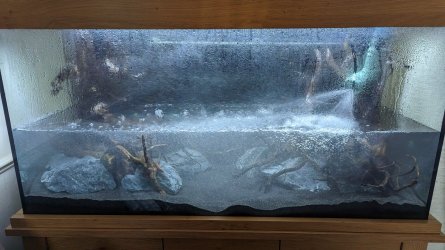Thanks. Feels a bit like it.
When's the 'sit back and enjoy the thriving tank Ive created' start?
Good suggestion that makes a lot of sense, but I've got a tank full of plants to keep going at the same time.
After the last big water change though, the remaining fish don't seem to be dong so bad. I can see a sparkling grouami and a pygmy cory dancing around together as I type.
It's tempting to just let things carry on as normal from here. They've looked OK at a few different points since I set it up though, so I really don't trust they'll stay that way.
My best guesses so far are either something about the wood, or the sooty stuff I kept finding in the filter from the substrate.
During my week off at the end of the month, I'll do something like:
Move the few remaining fish and any shrimp to another tank
Pull it all apart
Put plants in a large tub I've borrowed, along with a heater and airstone to keep things moving a little.
Rinse the substrate thoroughly
Boil wood in a big stainless pan thing I've borrowed, then attack it all with a stiff brush & rinse
Brush/scrub filter & pipework, inline heater and CO2 defuser with water that's as hot as I dare without melting anything.
Kill everything in the filter media with boiling/hot water
Spray the inside of the tank with white vinegar. Should kill anything that's left and be safe after a good rinse.
Try to polish out a couple of annoying scratches I've put in the front glass, rinsing well afterwards.
Put it back together, with a bunch of that 'start things immediately' stuff.
I may well use the current subtrate along the back and sides, with dark sand in the middle and maybe along the front. I do like how it looks and it'd be better for the corys.
I'm not really decided yet. Just got a bit of £ in it, that's all.
Completely understandable! Also understandable that you prefer the darker substrates over the light sand colours!
It's okay! You're absolutely fine, you're listening to and considering the advice, which is great! It doesn't mean you have to agree and follow everything, no one expects that. You're assessing and making your own decisions after seeking input from a range of people, then making your own informed choice. That's sensible, and all anyone should ask of you.I'm honestly not disagreeing with good advice, just find it hard write off a whole type of substrate that's commonly pushed as great for planted tanks. Good money's charged for this kinda stuff, y'know. I guess people charge for unsuitable or rubbish stuff all the time though.
What's the best away to make sure plants have something to feed off in the substrate? Root tabs and mulm over time?
Mulm doesn't really build up in sand. The muck lands on the surface and is swept into the filter usually. Adding root tabs under root feeders like swords, crypts, vallis etc, and using liquid ferts for all of the others works just as well as a planted substrate. I'd recommend setting up a reminder on your phone for when you need to add more, if you're anything like me. I'm terrible for forgetting to add ferts until I realise the plants aren't growing so well, then remember I haven't added ferts for a while.
The only thing I'd warn about with this, is that mixing substrates usually leads to them creeping into each other and mixing. Even though it's what I did, when I added a sand beach front half to a tank while leaving the back part gravel:I may well use the current subtrate along the back and sides, with dark sand in the middle and maybe along the front. I do like how it looks and it'd be better for the corys.
I only meant for it to be temporary, I had planned to tear down and rescape with it being only sand. I didn't end up doing that since the pygmies were thriving so well as it was, and I didn't want to fix what wasn't broken, so I've kept it that way. But it's huge pain, in that the gravel creeps forward, and sand gets knocked back under the gravel, so I've had to top up the sand several times, and every maintenance I wind up having to use a sieving tool thing I found to sift gravel out of the sand and put it back where I want it. If I leave it, eventually the gravel winds up covering the sand beach. You can see above that I use river stones to try to create a bit of a wall, which helps a little, but not entirely.
So if you do go for something mixed, I'd recommend designing a better way like an acrylic divider to keep the substrates separated!
Oh, and @seangee The Unipac black limpopo sand doesn't need much rinsing at all. When I went to rinse mine out in a bucket before use, water remained remarkably clear both when I was rinsing, and when I added it to the tank. I probably would have been fine even if I hadn't rinsed it at all, it was so clean.

